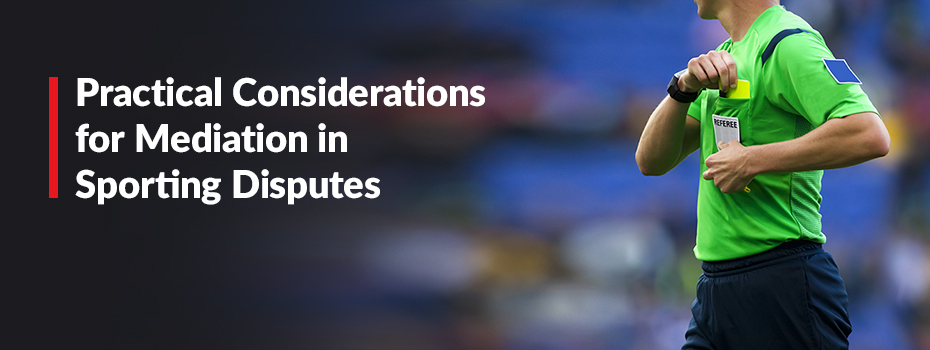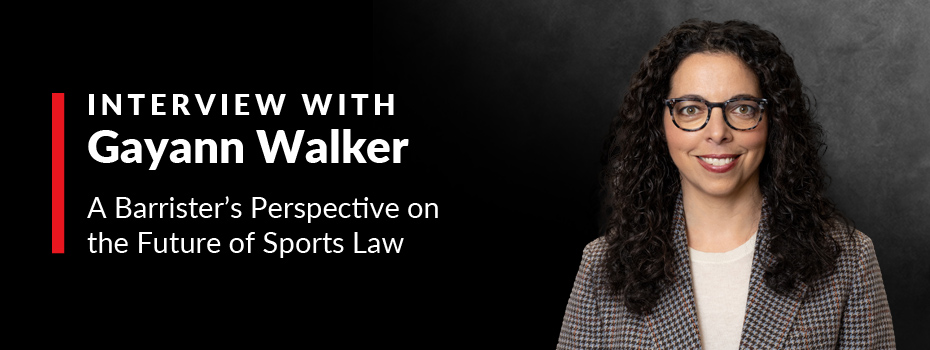
Practical Considerations for Mediation in Sporting Disputes
22 March 2023 06:57
Peter Agardy, VICTORIAN BAR
In 1962, during the Cuban missile crisis, then Chairman of the Council of Ministers of the Soviet Union, Nikita Khrushchev, wrote to the President of the United States of America, John Kennedy the following words:
Mr President, Mr Kennedy, you and I are like two men pulling on a rope with a knot in the middle, the harder we pull, the tighter the knot until it will have to be cut with a sword. Now why don’t we both let up the pressure and maybe we can untie the knot.
While the Cuban missile crisis is a long way from sports law disputes, the image is powerful reminder that the parties to a dispute — any dispute — can co-operate in untying the knot rather than having a solution imposed on them.
There are a myriad of ways to resolve disputes. When matters are of a legal nature in relation to sport, we tend to first think of the common dispute resolution methods such as litigation or arbitration. Perhaps due to the policy frameworks and contractual obligations surrounding sport, mediation is not front of mind. However, mediation offers participants an opportunity to resolve disputes amicably and for the good of the sport (at least when the parties are negotiation in good faith). The core features1 of mediation are:
- It is a decision making process in which the parties make and own the decision.
- The parties are assisted by an independent mediator.
- The parties are in control of the process.
- The parties can negotiate flexible outcomes that would not be available with an imposed solution. A judge, arbitrator or tribunal panel cannot split the difference. The parties are free to craft a resolution that is purpose built, subject to applicable rules and policies.
- The process is confidential, as opposed to litigation, which is usually in open court or, for example, arbitration in the National Sports Tribunal who publish decisions on their website.
- It can also be time efficient given the demand on sporting codes to conduct matters timely, often within a season or sooner. Also, the careers of athletes are fleeting. A delay of a year or two can wipe out a significant percentage of an athlete’s prime.
- Mediation is less costly than litigation.
Mediation provides an opportunity to preserve an ongoing relationship, whether that be a relationship between an athlete and a club, between clubs and leagues or even the management of spectators at sporting events. Additionally, mediation can assist the parties in finding a forward focused path such as mediating the negotiation of a future contract. Litigation is devoid of these opportunities. While there are no fixed rules for running the mediation process, mediation usually offers to the mediator an opportunity for a confidential and private intake session at the beginning of the mediation. There is also usually a joint session in which the parties can outline their respective positions. A joint session is most productive when the discussion is respectful and the mediator is able to control aggressive participants.
A search of the internet reveals many contributions about mediation in sport2. The internet contributions invariably extoll the virtues of mediation in sporting disputes. Many of them also lament that mediation is not resorted to as often as it could be.
Sport is big business. And where there is big business there are invariably disputes.
The question remains, what is the best way to resolve disputes.
Blackshaw observes that alternative dispute resolution (ADR), which includes mediation, “... lends itself to the settlement of sports-related disputes because of the special characteristics and dynamics of sport . . .” encapsulated in the expression “specificity of sport”3. The meaning of the expression “specificity of sport” is debated in Europe. It has no legal force in Australia.
Mediation is suitable for a wide variety of disputes. Many sport-related disputes are really just commercial disputes in which there is a sportsperson or a sporting association involved. The classic case is a contract dispute4.
Many commercial contracts now provide that the parties must attend mediation before commencing proceedings in a court or going to arbitration. That is also consistent with legislation that imposes on potential litigants an obligation to attempt to resolve disputes before commencing an action, such as the —Civil Procedure Act 2010 (Vic).
Blackshaw points out that many sports federations now include in their constitutions specific provisions for the mediation of appropriate sports disputes.
It is generally accepted that there are some disputes in which mediation is not appropriate. These include doping disputes and some disciplinary cases. But the majority of cases are suitable to submit to mediation.
Blackshaw reviews the mediation service offered by the Court of Arbitration for Sport (CAS)5. He offers examples of disputes that have been settled by CAS mediation. These include disputes between athletes and their advertising agencies in relation to commission payments.
We have a classic example here in Australia:
The late, great Henry Jolson was appointed mediator in a complaint about an episode of the Footy Show in 1999. Nicky Winmar had been invited to the show but he cancelled his appearance. Sam Newman painted his face black in mockery. There was uproar amid allegations of racial vilification. The mediation processes resulted in apologies being delivered, something that a court would never order. In some states, there is a formal scheme established. For example, Sport SA, in South Australia, established a State Sport Dispute Centre (www.sportssa.org.au). The purpose was to provide a confidential and impartial mediation and dispute resolution service for the South Australian sporting community. According to its website, the centre can handle a diverse range of disputes, including:
- workplace disputes;
- disciplinary hearings and selection disputes;
- disputes relating to the appointment of coaches and other officials;
- employment disputes;
- member complaints of harassment and discrimination; and
- grievances relating to volunteer screening.
The centre also offers the provision of trained and independent persons to chair tribunal hearings (fees apply).
The National Sports Tribunal (NST) can also assist parties in mediation in certain circumstances. Recently, the CEO of the NST John Boultbee suggested that the NST could assist in the Hawthorn Football Club investigation through its arbitral process6. I suggest that perhaps its mediation powers may be more effective given the healing that can occur during the process.
One advantage of mediation is that a mediator has an opportunity, through the use of private caucuses, to speak with the parties separately and confidentially. Grabowski refers to the mediator’s ability to “mend fences” before bringing the parties together in a room to talk7.
Psychologists note that lawyers do not always spend sufficient time in the intake sessions — conducted privately with the parties. This is often the product of budgetary constraints. An intake session is a good opportunity for the mediator to assess what the parties really want and what drives them.
For example, when a party is angry it may be that they are afraid. The mediator can try to ascertain what the fear is so that the mediator is better prepared to help find some middle ground. While your stereotypical heavyweight boxer may not want to reveal their feelings, subtle probing by an independent third party can assist in getting to the crux of the issues.
Grabowski also points out that one difference between sport negotiations and other negotiations is that in an ordinary commercial dispute, there are usually two parties each pressing its own interests8. However, sports negotiations tend to be more complex with other interested parties behind the scenes of the dispute. These include the sports associations and the fans. There might also be government interest in connection with grants to sporting bodies and the requirement for proper governance.
A mediator is likely to emphasize that mediation offers a golden opportunity to resolve a dispute and achieve finality in a confidential setting. The parties can settle their disputes “within the family of sport”, an outcome sought after by many sporting codes and evidenced by the fact that sporting codes rarely, if ever, make public determinations of their internal tribunals9. While this is a noble objective, care must be taken to avoid the coercion of parties to settle to avoid adverse publicity.
Sometimes sports disputes spiral out of control. The passion for the sport and the competitive spirit can spill over into the legal process. One example is the case of Mr Ragless, who was expelled from the South Australian Field and Game Association Southern Branch Inc (a clay target shooting club). He blamed Mr Stokes. The dispute involved no less than seven court battles10. One can only speculate whether an early mediation might have avoided all of that cost and distress.
It can be worthwhile for a mediator to point out what would happen if the dispute went to court or arbitration. First, the individuals involved are silenced. Parties in litigation are not permitted to speak with the judge or the arbitrator directly. All communications are completed through lawyers and the message is filtered through legal language and restrained by protocol.
Further, litigation takes place in open court. Interested individuals, whether they be media, sponsors, groups of fans or competitors can access documents that are filed and potentially watch the proceedings. From a public relations perspective, there are no winners. Significant public interest in an adverse event may impact corporate investment in either a league, club, sporting code or athlete.
Some disputes arise out of the rules of voluntary sporting associations. What must be borne in mind in these disputes is that some of the participants, perhaps the leaders of community associations, are well-meaning amateurs. They are not always commercially astute or considered legally sophisticated. Those same individuals may have overseen the drafting of the rules of their associations subject to challenge.
Lord Denning put it well in his book The Discipline of Law, although not specifically in reference to sporting associations:
Whenever a difference arose between a voluntary association and its members, the Courts said “Let us look at the Rules”. Then they got into a pretty pickle. Usually because of the obscurity of the Rules. In point of drafting, the Rules of these associations are the worst ever...”11
His Lordship suggested that the rules should be construed not literally but according to the spirit, the purpose that lay behind them.
Some sports administrators might not be aware of the benefits of mediation and the availability of mediators to assist in resolving disputes at the earliest opportunity. The message for sports administrators is that, if there a dispute that could embroil them in an ongoing, costly matter that has the capacity to affect a working relationship, then it would be wise to obtain advice prior to the matter getting out of hand.
Practical considerations for mediation of sports disputes
The first is that in any dispute with legal overtones (which is probably most disputes) having a legally trained meditor is beneficial. Mediation occurs in the shadow of the law, and it is helpful if the mediator has some idea of the possible consequences if there is no resolution and the dispute proceeds to litigation. The mediator does not offer legal advice, but does need to be aware of the broader options and issues such as costs consequences.
Secondly, it is helpful for the mediator to have some knowledge of the sport involved. The parties want to establish a rapport with the mediator and some understanding of the sport enhances the mediator’s credibility with the parties.
Finally, the parties can agree on the terms of settlement, including what can be published about the process and the outcome. This might be by way of press release or a notice sent to relevant stakeholders containing information such as confirming that a mediation took place and either outlining the terms of settlement or announcing that the settlement was condiential. By contrast, in litigation the whole of the evidence is given in public, and the reasons for decision are published to the world.
Mediation is becoming a standard facet of the litigation process, and includes an increase in popularity of mediation of sporting disputes. As Blackshaw concludes:
There is, therefore, plenty of work for lawyers in the foreseeable future in this particular and growing field of ADR practice and long may this continue to be the case!12
Peter Agardy
Barrister
Victorian Bar
Latest Articles
-
 Gayann Walkers is a well-respected Victorian Barrister. Tis interview focuses on what it takes to be a Barrister in sports law, and what the future of the field looks like.
Gayann Walkers is a well-respected Victorian Barrister. Tis interview focuses on what it takes to be a Barrister in sports law, and what the future of the field looks like. -
 The growth of artificial intelligence technologies in Australia has recently come under the spotlight, as the Albanese Government looks to review existing regulatory and governance mechanisms and establish applicable safeguards that are fit for purpose in the current day and age.
The growth of artificial intelligence technologies in Australia has recently come under the spotlight, as the Albanese Government looks to review existing regulatory and governance mechanisms and establish applicable safeguards that are fit for purpose in the current day and age. -
 Artificial Intelligence (AI) is developing fast – but how should it be used? Over the past month, the ethical use and development of AI have been heavily scrutinised as policymakers, intellectuals, and industry leaders debate whether a moratorium should be imposed on AI’s development, or whether AI should be embraced in the name of economic growth.
Artificial Intelligence (AI) is developing fast – but how should it be used? Over the past month, the ethical use and development of AI have been heavily scrutinised as policymakers, intellectuals, and industry leaders debate whether a moratorium should be imposed on AI’s development, or whether AI should be embraced in the name of economic growth.
Practical Guidance
Your one-stop solution for accurate legal answers from Australian legal experts. Tools, practically focused guidance notes, checklists, precedents, and training materials support and streamline your legal workflow.
LEARN MORE LexisNexis
LexisNexis